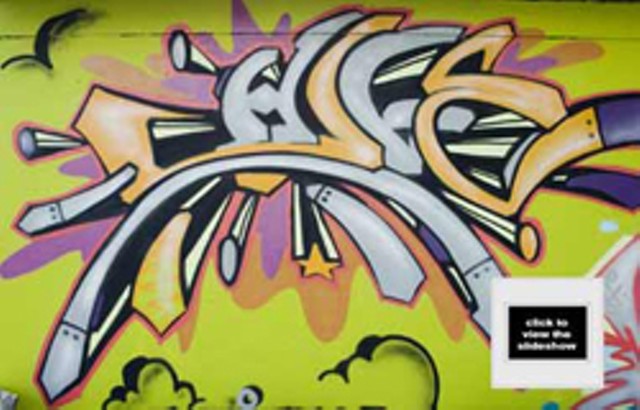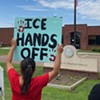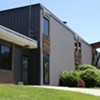Published June 13, 2007 at 4:00 a.m.
Nearly 10 years ago, someone painted an image of a gardener planting hearts on a crumbling brick wall at the corner of North Street and Elmwood Avenue in Burlington’s Old North End. “Planting Peace,” as the mural’s creator, Carol Usher, titled it, became a neighborhood landmark. It inspired community-gardening projects and drew attention away from a nearby cluster of scrawled graffiti. A photograph of the mural even landed on the cover of a book — Vermonter Ron Krupp’s The Woodchuck’s Guide to Gardening (Whetstone Books, 2001). Recalls Doug Hoffman, longtime pastor of the Jubilee Church and now the Kids A.L.I.V.E children’s church on Elmwood: “It was really a point of contact in the neighborhood; the kids loved it . . . it was a beautiful thing.”
But murals have uncertain lives. Early last month, “Planting Peace” vanished when the brick wall and adjacent building were demolished for safety reasons. When it came down, a project manager at the site surveyed the rubble and concluded, “Well, you can call it one thing; I call it graffiti.”
So what’s the difference between murals and graffiti? It depends on whom you ask, but permission to paint — or lack thereof — is the bottom line. (See accompanying article, “Talkin’ Tags,”) Stylistic characteristics shape impressions, as well: Most graffiti comes in the form of spray-painted names, or tags — such as those discovered recently atop the brand-new Courtyard Marriott hotel on Battery Street. Most murals are figurative, even narrative. They’re the ones Burlington’s Graffiti Removal Team (GRT) doesn’t try to erase. Around downtown Burlington, you can find plenty of examples of both art forms — good and bad — and the two often clash.
Angie Spong is the director of the GRT at Burlington’s Center for Communities and Neighborhoods (C-CAN). One of the team’s strategies for combating graffiti, she explains, is organizing community members, former taggers and local nonprofits to create murals at chronically spray-painted sites. “By creating an atmosphere that shows the place is cared for,” Spong says, “I hope that can sometimes cause taggers to think twice.”
On May 17, the GRT installed a series of 11 small murals on a fence at the corner of North Union and North streets. Kids and adults from the Boys & Girls Club, the King Street Youth Center and the Howard Center were among the contributors. Coated in a spray-paint-resistant finish, the murals bear messages that are meant to give observers pause, such as a Martin Luther King, Jr. quote: “Life’s most persistent question is: ‘What are you doing for others?’”
Historically, of course, murals have had many inspirations besides keeping graffiti at bay. The form can be traced back to the first cave paintings, which are about 30,000 years old. The tradition includes some of the world’s most renowned and beloved art works — think Michelangelo’s Sistine Chapel — and has often been used to broadcast appeals for political or social activism. Mexican muralism, a bona fide school of art, is defined by the style in which artists such as Diego Rivera and José Clemente Orozco painted leftist political themes in the 1920s and ’30s. (Orozco’s monumental, 24-panel mural, entitled “The Epic of American Civilization,” is installed at Dartmouth College.) In the 1980s, artist Keith Haring married social activism to urban, street-smart style. The graffiti-writer-turned-superstar-painter made famous the “Crack is Wack” anti-drug message through one of several murals he painted — with permission — in New York City.
Though they’re generally less dramatic, Burlington’s murals reflect all sorts of raisons d’être: civic collaborations, activist messages, historical narratives, jokes, constructive outlets for former taggers, weirdness and just plain artistic expression. Underlying them all is a basic impulse to engage the community through art. Burlington artist Gina Carrera, a volunteer with the GRT, has been painting murals since the early 1990s. “Why do I do it?” she muses. “Because we’re so saturated with information — I try to make it so people can get away, take a breath for a second.”
What follows is a “get-away” guide to many of the city’s murals. All are in walking distance of downtown Burlington. Caveat: The list is long, but not comprehensive; chances are you’ll discover dozens more murals along the way.
*****
Main Street near University Heights
Created in the late 1980s, the mural outside the Living/Learning Center at the University of Vermont is probably Burlington’s oldest surviving outdoor painting. According to center director Pat Brown, a student organization commissioned a Central American artist to help raise awareness about injustice in El Salvador. The 48-foot-long piece unfolds themes of education, religion, agriculture and oppression. In its center, a determined-looking group of people march, holding a banner that reads “Solidarity for Peace in El Salvador.”
This is one of the city’s most overtly political murals, bringing it closest to the tradition of communicating activist messages. Its bright colors and thick black outlines reinforce the overall theme of strength.
Two collaborative pieces made by members of the UVM community flank the El Salvador mural. One is a fervent ode to environmentalism, featuring a dream-like natural vista overlaid with poems, lyric fragments and imperatives (“Bliss Out!”). The other is a response to 9/11, painted between October 5 and November 15, 2001, and dedicated: In loving memory of those affected by war. This mural is densely packed with small images and text conveying hope, grief and calls for peace.
Corner of Pine and Locust Streets
For the South End Art Hop in 2005, Burlington artist “Airbrush Ron” Hernandez painted the Buddha — or rather, giant Buddha face — on a small building belonging to the Burlington Electric Department. The best way to approach it is head on, walking west on Locust Street toward Pine — the Buddha’s sky-blue, rather bored-looking eyes will gaze right at you. Two adjacent sides of the building are painted with giant waves of flowers and water. Hernandez calls them “tsunamis of peace.”
Peaceful as it may appear, the mural originally brought a flood of criticism, followed by censorship. When Hernandez first painted it, the waves were crashing down on weapons. Some citizens complained to BED that the mural’s message was “too antiwar,” eventually prompting Hernandez to paint over the offending images. Objections subsided, but now graffiti tags are a recurring problem. Hernandez, who has painted several murals in Burlington and elsewhere in Vermont, is trying to organize a project to encourage taggers to redirect their energies into making murals. “I think that murals are an inspiration to do something better,” he suggests.
157 South Champlain Street (between King and Main)
Painted on the south side of an abandoned building, this mural depicts elements of destruction, healing and growth in nature. From the left, a large fire encroaches on evergreens, wildflowers and palm trees. On the right, aloe plants counterbalance the fire. The painting’s strong greens and yellows are visible half a block away.
Noah Krowther, owner of a Volkswagen repair shop next door, painted this mural in fall 2006 with three helpers and the guidance of Frank Gonzalez. An artist and intermittent Burlington resident, Gonzalez has a resume that includes several murals he painted in Mexico City in the 1970s. “He really got us in gear to do it,” says Krowther. “He pushed and pushed, and helped us with materials.” Though Krowther considers the mural unfinished, he enjoys it and the positive feedback he’s received. “It kind of spices up the old building,” he says.
King Street Ferry Dock
Downtown Burlington’s largest mural — more than 150 feet long and two stories high — appears at the bottom of King Street on the west side of the Burlington Shipyard Building. Painted in 1995 by artist Gina Carrera, it depicts a scene of Burlington Harbor circa 1900.
“I wanted to express the heavy logging industry at that time,” Carrera says. “I was looking at a lot of historic photographs and decided I wanted to create something special as a gateway for people getting off the ferry.” She approached the Lake Champlain Transportation Company, whose representatives liked the idea and provided her with paint and scaffolding for the job. Carrera says she completed it in just 47 hours.
The viewpoint is from the middle of the lake and includes the old Burlington Yacht Club (now the Burlington Boathouse) and three steamboats, with the city in the background. The mural sustained significant damage during the 1998 ice storm, but what remains is an enticing rendering of the city’s past.
Carrera notes that, at one point in the mid-1990s, she had nine murals around Burlington. Most have been painted over; her only other intact piece is “The Rainforest” (see below) on Church Street.
Union Station, 1 Main Street
Another historical mural, this one tracing the evolution of the Burlington waterfront, lines a long wall inside Union Station on the lower level. Melinda Moulton of Main Street Landing Co., which developed Union Station, commissioned the nine-panel painting 10 years ago. She selected the images from a group that had been used in a slide show about Burlington history and asked artist Nancy Barnett to reproduce them.
The sepia-and-brown paintings illustrate nearly 400 years of history, from Champlain’s arrival, to logging and railroads, to the height of the steamboat era. The images also depict the waterfront’s industrial decline during the mid-20th century and subsequent rebirth as a vibrant community space and event site. The final panel could be a combination of the Discover Jazz and Chew-Chew festivals.
1 Steele Street, on the Bike Path
A tall, skinny mural — about 15 feet high and 2 feet wide — is stationed just outside the Wing Building and the headquarters of sustainable transportation advocates Local Motion. Artist and former Burlington resident Kate Hodges painted the piece in 2001 at the request of Local Motion founder Chapin Spencer. Energetic colors and brushwork complement the mural’s subject: car-free transportation. Smiling bikers, joggers, kayakers and skateboarders zip around — along with the now-defunct Champlain Flyer commuter train.
Spencer wanted to get his message across with a mural, but his aesthetic motivation was strong as well: “There’s a lot of gray and asphalt around here,” he says. “It’s good to have a little color!”
Hodges has a second waterfront mural at Perkins Pier, at the bottom of Maple Street. Overlooking a small playground is a lake-and-mountain scene with dramatic swirls of bright reds and greens; large white birds fill the sky. Painted in 2004, the mural is signed by Hodges and Maja Freeman.
60 Lake Street
Another of Melinda Moulton’s mural commissions appears on the third floor of 60 Lake Street, a.k.a. Lake & College. “Airbrush Ron” Hernandez (of Buddha fame) painted the ceiling with a 360-degree vista of the Lake Champlain valley. For best results, a viewer should stand, or maybe lie, directly beneath the center. Hernandez has assigned a season to each direction: To the south is autumn in peak foliage, west in the Adirondacks it is winter, the northern islands are enjoying spring, and summer reigns in Burlington and the Green Mountains. Rising over all, a night sky extends to four skylights.
The beautifully painted mural elicits “lots of wowee-zowees” from visitors, according to Moulton. It’s also a favorite of Hernandez, who has been airbrushing in Vermont since the early 1970s.
2 Pearl Street (corner of Pearl and Battery)
Six murals are packed on to the newly turquoise walls of the small building that is Ridin’ High Skate Shop. Several are in the graffiti style, complete with day-glo spray paint, but there’s also a wonderfully sinister, silhouetted figure on one corner of the building, and to the right of the entrance is a tree dripping with vines. In the middle of the wall facing Battery Street, a totem pole bears several faces; the shop’s name is painted near the top.
Shop owner John Van Hazinga says he’s featured about 20 artists on Ridin’ High so far — he tries to rotate in a new crop of murals each year. This skater-curator approach has produced a gallery of sorts for pieces that are pointedly different from the more typical community- and environment-themed murals in Burlington.
85 Pearl Street
On the east wall of The Dough Boy Coffee Shop, in the shadow of the Cathedral of Immaculate Conception, resides “Eggman Comes to America.” This unusual creation comes from Burlington artist Tony Shull, who says he’s been painting murals around town for nearly 40 years. Humor is in short supply on many Queen City murals, but there’s a touch of tongue-in-cheek ’tude here.
Shull’s Eggman — a large egg with arms, legs and a smiling face — has just crossed a body of water and is stepping ashore carrying a large American flag. The rest of the approximately 50-foot-long mural is dominated by nine large trees, each embraced by one or two people. Why so many tree-huggers? “Oh, I just thought it would be funny,” says the artist. “I thought it would be perfect for a place like Burlington.”
Shull says he conceived the idea of Eggman after 9/11. “Everyone had flags everywhere,” he recalls. “I said, ‘OK, I’m going to have the Eggman holding a big American flag.’”
Shull’s revised the Eggman mural a few times since 2001, and calls it “a work in progress.” As of this writing, he was waiting for the rain to stop so he could do some more painting.
8 North Winooski Avenue (near the corner of Pearl) (10)
A crow in sunglasses playing an upright bass runs up the front of the Radio Bean coffee house, to the left of the entrance. Approximately 2 feet wide by 12 feet tall, this gem was painted by Burlington artist Michael Tonn in 2005.
The idea for the mural came from Lee Anderson, the shop’s owner, who was inspired by public artworks he saw during a visit to Amsterdam. Anderson approached Tonn and asked for a “hip-looking bird.” He adds, “I’ve always connected with crows. The crow often plays the role of prankster in mythology . . . undermining authority, but in a constructive way.”
Anderson notes that he’s asked Tonn to paint a second mural next to the entrance — a crow playing the saxophone — and expects it will be completed this summer.
56 Church Street (between Bank and Cherry)
With a high-profile location in the alley between Maplehurst Florist and Banana Republic, Gina Carrera’s “The Rainforest” may well be the most frequently viewed mural in Burlington. A long, sprawling jungle scene features groups of animals — cheetahs, lions, pandas and a few exotic Holsteins, to name a few. When Carrera painted “The Rainforest” in 1992, her aim was to make it particularly relevant to children by demonstrating that animals also have families. In addition to the mural’s title, she painted in the names of local businesses that donated materials or money toward its completion.
The city is currently floating proposals to enhance the appearance of this alley, which is a gateway to Church Street from the parking garage. The eventual overhaul could include painting or bricking over Carrera’s work.
75 South Winooski Avenue (between Bank and Cherry)
The murals on the walls behind Handy’s Texaco are the work of four young artists who approached owner Charlie Handy in 2006 for permission. They consist mostly of sophisticated, spray-painted tags, but include a well-painted celestial scene. The murals are dedicated to Handy’s father Salamin, who died in 1997.
Handy says he’s happy to support mural painting if it redirects or discourages vandalistic impulses. “As long as they don’t insult or hurt anybody, I don’t mind,” he says. “I just want light, happy things that make the town presentable.”
Center Street (across from The Daily Planet)
Artists have painted at least half a dozen murals on the back wall of the Mobil station across from the Daily Planet Restaurant. Since 2002, though, it’s been home to “Flight, Freedom, and Dreams.” The 13-by-65-foot work was a collaboration between VSA Arts of Vermont and other nonprofits that aimed to discourage graffiti through public-art projects and to offer creative opportunities to adults with developmental disabilities. Kate Hodges led this project — her signature swirling colors and soaring birds dominate the mural. More than 40 people joined Hodges in the effort; their contributions are found mostly in smaller details at eye level.
13 Center Street
The south-facing wall of the building that houses the Daily Planet and Rapunzel Salon overflows with a restaurant fantasia — giddy diners float among fish, burgers, roast turkeys performing calisthenics, a waitress in hot pink heels and, inexplicably, a rocket. Almost everything is upside-down. The candy-colored mural, signed “Yelodog” and also “Sarah Lee Woodard with help from Edgar Stewart,” has survived for more than a decade.
156 Church Street (corner of Church and Main)
From the top of a wall at 156 Church, which houses Smokejacks restaurant, a pair of mysterious, almost identical blue faces stare blankly. They merge with the profile of a third face, gazing toward the lake. The trio of faces dominates a jumble of spray-painted forms and elaborate tags that would be right at home in the New York City subway.
Observers get the best view of this wall from the third floor of the Firehouse Gallery across the street. “I love those faces,” says gallery curator Ruth Erickson. “People comment on [the mural] a lot. They say, ‘Ooh . . . cool graffiti.’” So, is it a mural or graffiti? “I guess it’s a fine line,” observes Erickson.
According to building owner Larry Bohen, the work was painted “about four or five years ago,” in part to discourage the significant tagging the high-profile wall had attracted. Burlington City Arts approached Bohen with the idea, and the mural was eventually painted by a small group of artists with connections to Burlington design firm Jager Di Paola Kemp.
Alley off Main Street, between Nectar’s and Esox
Three small murals painted with acrylic appear on the external wall of Esox. Each was painted in 2006 by different people, though the consistency among them suggests otherwise. On the right is a portrait of the Virgin Mary painted by Tony Shull (see “Eggman Comes to America”). Was he trying to say something by painting Mary on a bar? It was more of a tactical decision, Shull explains: “A few years ago in that space I painted a doctor holding a Pepsi. Then on Green-Up Day they painted over it. So I painted the doctor again, and on the next Green-Up Day they painted over it again. So I said, OK, I’ll paint the Virgin Mary. Let’s see if they paint over that.” So far, so good. While Shull was painting Mary, he says, a couple watched. They left and soon returned with paints to contribute a variation on his subject. The three painted ladies in a row bear an eerie, mysterious aura befitting a dark alley.
Roosevelt Park
Four large murals blanket the outside of a utility-and-public-restroom building in the middle of Roosevelt Park in the Old North End. The most prominent, called “Hands Are Not for Hitting,” was spearheaded by artist Jeannie Waltz in 1995 and named after an anti-violence campaign organized by area nonprofits, including Women Helping Battered Women, the Women’s Rape Crisis Center and VSA Arts of Vermont.
The design depicts two hands joined in front of a large, rainbow-colored heart. Most striking about this mural: some 700 dipped-in-paint handprints applied by community members after they signed a pact against violence.
Burlington’s most abstract mural fills a second wall on the building: The loose assemblage of simple shapes with rounded edges evokes an incomplete jigsaw puzzle. Burlington and Louisiana artist Clark Derbes painted it in 2003 at the request of the city’s anti-graffiti team, with the help of several volunteers. The design is distinctive, but Derbes’ motivation was mostly logistical: “I just wanted to do something flat-shaped that the community could execute easily,” he explains.
Derbes painted this mural around the same time he was covering several downtown electrical and traffic-control boxes with similarly colorful shapes. These box paintings were endorsed by the Department of Public Works and generally well received by the community as an improvement over gray metal, but they didn’t last long. Burlington City Arts recycled Derbes’ idea earlier this spring with a request-for-proposals to paint four boxes in the downtown area.
A third wall of the Roosevelt Park building features a slightly fantastical Lake Champlain vista combining Champ and palm trees. The fourth mural sets 15 silhouettes of adults and children at play against a brightly colored background.
C-CAN’s Angie Spong says tagging is “relentless” at Roosevelt, but the GRT and other community members are doing what they can to make it less prominent. Kids and staff from the nearby Boys & Girls Club of Burlington recently painted over tags — a visit in mid-May found the murals nearly graffiti-free. “Who knows? If those murals weren’t there, it could be worse,” Spong says. “It’s much better than blank walls with tags.”
View a Slideshow of Burlington Murals
Speaking of...
-

Morrisville Sculptor Thea Alvin Is Recognized With $100,000 Craft Award
May 22, 2024 -

Q&A: Catching Up With the Champlain Valley Quilt Guild
Apr 10, 2024 -

Video: The Champlain Valley Quilt Guild Prepares for Its Biennial Quilt Show
Apr 4, 2024 -

Q&A: Meet a Family in Waterbury That Embraces Halloween Year-Round
Feb 14, 2024 -

Video: Goth Family in Waterbury: Sarah, Jay and Zarek Vogelsang-Card
Feb 8, 2024 - More »
Comments
Comments are closed.
From 2014-2020, Seven Days allowed readers to comment on all stories posted on our website. While we've appreciated the suggestions and insights, right now Seven Days is prioritizing our core mission — producing high-quality, responsible local journalism — over moderating online debates between readers.
To criticize, correct or praise our reporting, please send us a letter to the editor or send us a tip. We’ll check it out and report the results.
Online comments may return when we have better tech tools for managing them. Thanks for reading.








































